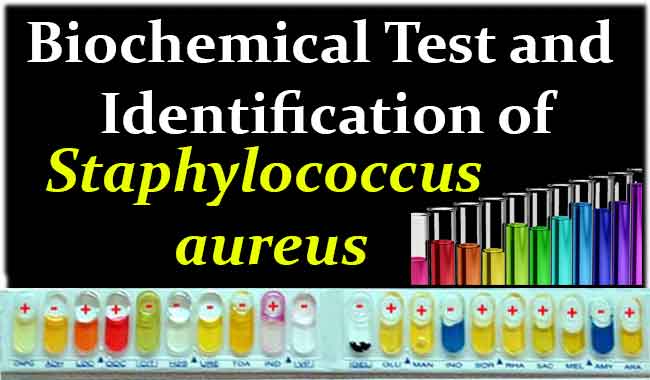| Basic Characteristics | Properties (Staphylococcus aureus) |
|---|---|
| Capsule | Non-Capsulated |
| Catalase | Positive (+ve) |
| Citrate | Positive (+ve) |
| Coagulase | Positive (+ve) |
| Gas | Negative (-ve) |
| Gelatin Hydrolysis | Positive (+ve) |
| Gram Staining | Positive (+ve) |
| H2S | Negative (-ve) |
| Hemolysis | Positive (+ve)- Beta |
| Indole | Negative (-ve) |
| Motility | Negative (-ve) |
| MR (Methyl Red) | Positive (+ve) |
| Nitrate Reduction | Positive (+ve) |
| OF (Oxidative-Fermentative) | Fermentative |
| Oxidase | Negative (-ve) |
| Pigment | Mostly Positive (+ve) |
| PYR | Negative (-ve) |
| Shape | Cocci |
| Spore | Non-Sporing |
| Urease | Positive (+ve) |
| VP (Voges Proskauer) | Positive (+ve) |
| Fermentation of | |
| Arabinose | Negative (-ve) |
| Cellobiose | Negative (-ve) |
| DNase | Positive (+ve) |
| Fructose | Positive (+ve) |
| Galactose | Positive (+ve) |
| Glucose | Positive (+ve) |
| Lactose | Positive (+ve) |
| Maltose | Positive (+ve) |
| Mannitol | Positive (+ve) |
| Mannose | Positive (+ve) |
| Raffinose | Negative (-ve) |
| Ribose | Positive (+ve) |
| Salicin | Negative (-ve) |
| Sucrose | Positive (+ve) |
| Trehalose | Positive (+ve) |
| Xylose | Negative (-ve) |
| Enzymatic Reactions | |
| Acetoin Production | Positive (+ve) |
| Alkaline Phosphatase | Positive (+ve) |
| Arginine Dehydrolase | Positive (+ve) |
| Hyalurodinase | Positive (+ve) |
| Lipase | Positive (+ve) |
| Ornithine Decarboxylase | Negative (-ve) |


What is the reason behind S. aureus stored for long period showing White colour in case of golden colour?
Long-term storage causes it to lose the genetic components for pigment production in subsequent generations of the organism.
S.aureus give methyl red test positive. Pls give a reason???
Disregard the comments stating MR and VP test cannot both be positive. The fact of the matter is that they absolutely can both be positive. There are a number of organisms positive for both including: Proteus myxofaciens, Enterobacter intermedium, Klebsiella planticola and Serratia liquefaciens. Those stating otherwise please review the literature before commenting.
Same thing to point out – MR and VP test both can never be positive. Please provide the correction.
pls how can i identified E.coli strain in a culture madia
Depends on the culture – Like if u use EMB media it will give a metallic sheen and if u use MLA it will give pink coloured colonies because of Lactose fermentation.
if you use TSA its appeared white regular colonies
if you use ENDO agar is seems metalic sheen
if you use MCA you can see pink colonies whit zones
how can MR test and VP test both be positive. if one is positive ,other has to be
negative and vice versa . both can be negative, but both tests can never be positive.
Sagar sir, I am Amit khanal from B.Sc. Microbiology 4th year, St.Xavier’s college. I happened to be doing a practical homework on Enzymatic Activities of bacteria- one of which included COAGULASE TEST. After going through some of the literatures, including the (prescribed)college book itself; I found the lines:
1. Coagulase reacting factor—abbreviated as CRF—which in your site has been abbreviated as CRP
2. Tube test for coagulase tests both BOUND AND FREE COAGULASE.. mentioned only free coagulase on this site.
Could you shed some light in this ?
Thanks a lot
Hi, may i know what are the possible reasons as to why does s. aureus gives of positive result in Ornithine decarboxylase? thank you!
if the xylose broth was first yellow and it turned red, would it be a + or – reaction
can use PDA(potato dextrose agar) to identify or detect the growth? and what about the result outcome?
S. aureus is historically regarded as a non-motile organism. More recently it has been shown that S. aureus can passively move across agar surfaces in a process called spreading. Discovered that S. aureus can spread across the surface of media in structures that we term ‘comets’.
Thermonuclease -positive
Dear Sagar,
Can I have a question?
How can I do Bacitracin Susceptibility test for Staphylococci identification?
Thank you for your help.
Best regards.
Use Bacitracin Taxo A (0.04IU) as we did to identify S.pyogenes.
Diameter zone: S>=10mm, R<=9mm if I not mistaken (kindly refer Koneman's Book)
Used to differentiate between Staphylococcus, Micrococcus and Macrococcus
Staphylococcus/Macrococcus: Bacitracin resistant
Micrococcus: Bacitracin sensitive
To differentiate between Staphylococcus/Macrococcus, we can do glucose fermentation under anaerobic condition whereas Staphylococcus able to ferment glucose anaerobically (positive) whiles Macrococcus not able to ferment glucose anaerobically (negative). Micrococcus also not able to ferment glucose anaerobically (negative)
Hi sir, why Macrococcus and Micrococcus will not ferment anaerobically . can you explain please .
Which test’s Are used for the conformation in staphylococcus aures
above mentioned tests are used for confirmation of the Staphylococcus aureus. but first, you need to identify it by colony morphology then gram staining, microscopy, then catalase and oxidase test. when all of these test confirmed then apply above mentioned biochemical tests.
Xylose fermentation – Negative
Novobiocin sensitivity – Positive (non-biochemical)
Thank you 🙂